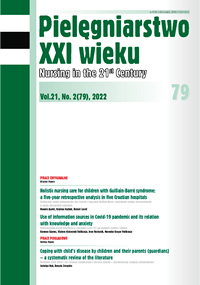Medical simulation as an educational tool in the opinion of nursing students
DOI:
https://doi.org/10.2478/pielxxiw-2022-0016Keywords:
nursing students, medical simulation, educationAbstract
TO MEDICAL SIMULATION AS AN EDUCATIONAL TOOL IN THE OPINION OF NURSING STUDENTSOL IN THE OPINION OF NURSING STUDENTS
Introduction. Nursing education combined with medical simulation is currently a modern method of education, which, especially in the era of the SARS-COV-2 pandemic, is an essential form of preparing the student for professional tasks.
Aim. The aim of the study was to fi nd out the opinions of nursing students about the classes conducted in the Medical Simulation Center.
Material and methods. A total of 186 undergraduate nursing students participated in the survey. It was conducted via the Internet. We used the method of diagnostic survey; surveying technique and the tool was the original questionnaire. The study was anonymous and voluntary and was conducted from February to May 2021. It is assumed that any relationship is statistically signifi cant when p≤0.05.
Results and conclusions. According to the respondents, medical simulation prepares to acquire practical skills, also consolidates theoretical knowledge, prepares to broaden social competence. For nursing students, its disadvantage is the lack of contact with the patient. Education realized with the use of medical simulation is an eff ective method of learning. Nursing students prefer to take classes in high fi delity rooms and with standardized patients because they are most similar to real life conditions.
References
1. Girzelska J, Guz E, Nieckula M, i wsp. Medical simulation – innovation in nursing education. Piel. XXI wieku. 2019; 18(4): 231-235.
2. Gąsiorowski Ł, Kuliński D, Stachowiak-Andrysiak M. The development of medical simulation centers in Poland – a strong opportunity for modernization of nursing education. Polish Nursing. 2016; 4(62): 598-601.
3. Gurowiec PJ, Sejboth J, Uchmanowicz I. Przewodnik do nauczania zasad pracy w warunkach symulacji medycznej na kierunku pielęgniarstwo. Opole; 202 s.17. 4. Żeromska-Michniewicz AK. Analiza cech symulatorow wysokiej wierności w dziedzinie pielęgniarstwa. Piel. Zdr. Publ. 2020; 10(3): 165-170.
5. Jeff ries PR, Bigley MB, McNelis AM, et al. A call to action: Building evidence for use of simulation in nurse practitioner education. J. Am. Assoc. Nurse Pract. 2019; 31(11): 627-632.
6. Jin HR, Choi YJ. Three-dimensional needs of standardized patients in nursing simulations and collaboration strategies: A qualitative analysis. Nurse. Educ. Today. 2018; 68(Sep.) :177-181.
7. Czekajło M. Symulacja medyczna jako profesjonalne narzędzie wpływające na bezpieczeństwo pacjenta wykorzystywane w procesie nauczania. Merkur Lekarski. 2015; XXXVII: 360-363.
8. https//csm.cm.umk.pl/wprowadzenie-do-symulacji-medycznej (as of June 10th, 2021)
9. Ribeiro VS, Garbuio DC, Zamariolli CM, et al. Clinical simulation and training for Advanced Nursing Practices: an integrative review. Acta Paul. Eneferm. 2018; 31(6): 659-666.
10. Starkweather A, Sargent L, Nye C, et al. Progressive Assessment and Competency Evaluation Framework for Integrating Simulation in Nurse Practitioner Education. J. Nurse Pract. 2017; 13(7): e301-e310. doi: 10.1016/j.nurpra.2017.04.012. Epub 2017 May 12. PMID: 30842709; PMCID: PMC6397912.
11. Luo D, Yang BX, Liu Q, et al. Nurse educators perceptions of simulation teaching in Chinese context: benefi ts and barriers. Peer J. 2021; 9: e11519. doi: 10.7717/ peerj.11519. PMID: 34178445; PMCID: PMC8214848.
12. Shin S, Park JH, Kim JH. Eff ectiveness of patient simulation in nursing education: meta-analysis. Nurse Educ. Today. 2015; 35(1): 176-182. doi: 10.1016/j. nedt.2014.09.009. Epub 2014 Oct 29. PMID: 25459172.
13. Guerrero-Martinez IM, Portero-Prados FJ, Romero-Gonzalez RC, et al. Nursing Students’ Perception on the Eff ectiveness of Emergency Competence Learning through Simulation. Healthcare (Basel). 2020; 8(4): 397. Published 2020 Oct 13. doi:10.3390/healthcare8040397.
14. Kowitlawakul Y, Chow YL, Salam ZH, et al. Exploring the use of standardized patients for simulation-based learning in preparing advanced practice nurses. Nurse Educ Today. 2015 Jul;35(7):894-9. doi: 10.1016/j.nedt.2015.03.004. Epub; 2015 Mar 20. PMID: 25819268.
Downloads
Published
Issue
Section
License
Copyright (c) 2022 Authors

This work is licensed under a Creative Commons Attribution 4.0 International License.




